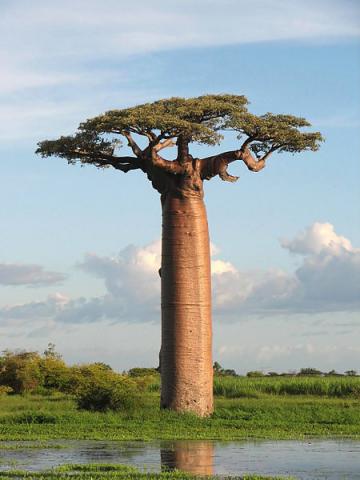Baobabs, with their swollen stems, are easily recognizable. Able to store large amounts of water, in their stems, they are known as a “Tree of Life” because they can help people cope with seasonal droughts. This image, by Bernard Gagnon, depicts a Baobab (Adansonia grandidieri) in Madagascar. License: CC BY-SA 3.0
In bright Madagascar
We see Baobab Trees;
But the land growing forests
Is oft-swept to the sea.
In Madagascar - like other places in Africa - the Baobab tree is special. It can live for thousands of years. The tree - especially when it does not have leaves during much of the year - looks upside-down. There is an old legend about that:
The baobab was among the first trees to appear on the land. Next came the slender, graceful palm tree.
When the baobab saw the palm tree, it cried out that it wanted to be taller.
Then the beautiful flame tree appeared with its red flower and the baobab was envious for flower blossoms.
When the baobab saw the magnificent fig tree, it prayed for fruit as well.
The gods became angry with the tree and pulled it up by its roots, then replanted it upside down to keep it quiet.
Baobab trees are often called "The Tree of Life." That's because people (and animals) use them for many different things:
- The bark is used for rope and cloth;
- The leaves are used for medicine;
- The fruit - called "monkey bread" - is used for food;
- The stems store "massive amounts of water" used during the dry season;
- The huge trunks are used as homes.
Madagascar - also home to a stone forest called Tsingy and part of the story for popular movies such as the Madagascar trilogy - used to be filled with all kinds of trees and a beautiful rainforest. Today, ninety percent of the rainforest's trees are gone.
The rainforest's trees have been cut down by people for different reasons. Some people needed the wood to heat their homes; others sold it to buy food for their families.
Trees and forests protect the land from flooding. They also help to clean the air and provide oxygen - for people and animals - through a process called photosynthesis.
Now that so many of Madagascar's trees have been cut down, flooding can happen which causes the land to erode. So much erosion has happened that some of Madagascar's land is falling into the sea.
Fewer trees also make life harder for the island's wildlife. Some of its special dwellers (including those which are now threatened or no longer exist) are included in this list:
- The Elephant Bird (now extinct, whose eggs were positively gigantic);
- Indiri (native to Madagascar, this type of tree-living lemur is endangered);
- Greater bamboo lemurs (the world's rarest lemurs) are also threatened;
- Of the 103 species of Madagascar lemurs, "more than 90% ... should be on the Red List of Threatened Species" (according to recent reports);
- Aye-aye (near-threatened, these primates sleep during the day and forage at night).
With only ten percent of their rainforest trees left, the people of Madagascar are working hard to protect them. How are similarly threatened rainforests in South America faring?


 Back
Back
 Next Chapter
Next Chapter

 Back
Back
 Next Chapter
Next Chapter



